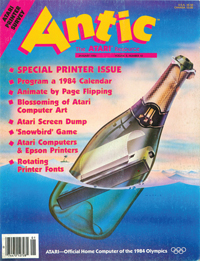|
Vaughan Family Timestream® Maps |
| Home Biography People Places Multimedia: Making It Work On the Water Writings/Presentations |
Pagewriter
Reviewed by Tay Vaughan
In Antic Magazine, January, 1984 (Page 111)
Product from: Alog Computing
1040 Veronica Springs Road
Santa Barbara, CA 93105
(805) 964-4660 (CA)
(800) 558-8803 (outside CA)
$39.95, 32K - disk
The real word is filled with compromises, and these are often dictated by the tools that are available to you. If you don't have a food processor, you use a knife to cut tomatoes. If yours isn't a sharp knife, you might have to quarter the tomatoes instead of thin-slicing them. In the worst-case compromises (with only a fork in hand), you might end up changing your menu to include freshly-squeezed tomato juice cocktail.
The options and procedures available to you for cutting tomatoes, or for word processing on your Atari, are legion. In all cases, however, it helps to have the right tools for the job.
On your Atari, one of the major compromises in word processing is dictated by the computer's "standard" 40-column display. A letter or manuscript is usually printed in an 80-column format, but your screen can display only half of the full printed-line width (without special add-on ROM boards and hardware), so you cannot see a fully-composed page as you work.
The Alog Pagewriter provides an inexpensive solution to this composition problem and belongs in the category of special tools which perform specific jobs. It is not a full-blown word processor, and it intentionally compromises many fancy features to function as a simple, straightforward text manager.
Pagewriter orients the user in terms of the standard 8-1/2 by ll-inch page, and its editing functions can be quickly mastered by users who are acquainted with the Atari keyboard or who have had experience with standard typewriters.
Most of the screen is devoted to a compositional display of the page being written, including margins, line spacing, line index, and indents. This display, however, does not include written text and characters, but graphic blocks and spaces representing the way the page will look when it is printed. In another window at the bottom of the page, the actual text of the line being written or edited is displayed. If the text is longer than 40 characters or exceeds the chosen margin settings, the text line wraps around.
Lines can be deleted, blank lines can be inserted, and individual words can be changed or corrected. You can view only one line of text at a time in the lower window, however, so reading what you have typed means scrolling line by line through your text. This makes it difficult to maintain continuity of thought when you are doing creative writing. For this, you may prefer a more expensive and capable word processor.
But for straightforward page-oriented writing tasks, Pagewriter performs well. Up to ten pages can be stored to disk for later recall, and control characters can be imbedded in the text for printer features such as condensed or elongated text. The system of storing page files to disk is not compatible with Atari DOS, however, so separately-formatted disks are required for each writing project.
As a simple word-processing tool, Pagewriter is useful in situations that require display of the finished composition and layout of the text. If composition is important to your work, this may be the special tool you need to avoid compromise.

